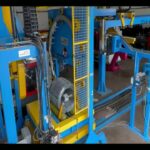The Role of PLC Controls in Coil Packing Line Automation
Are you struggling with inconsistent coil packaging quality and machine downtime? Manual processes cause costly errors that impact your bottom line. PLC-powered automation eliminates these headaches by delivering robotic precision 24/7. Discover how this technology revolutionizes coil packaging efficiency.
Precision in Motion: PLC Automation Framework
Programmable Logic Controllers (PLCs) serve as the industrial brain of coil packing lines, orchestrating every step with digital accuracy. These rugged computers monitor sensors, process real-time data through ladder logic programming, and execute commands to actuators and motors. By replacing manual sequencing with automated decision-making, PLCs ensure precise control over:
- Metal coil positioning accuracy (±0.5mm tolerance)
- Film wrapping tension consistency
- Strap application timing
- Output synchronization across multiple stations
Without PLC integration, modern coil packaging would be impossible – these systems achieve what human operators physically cannot through millisecond-level adjustments and continuous quality verification.
How PLC Systems Transform Coil Packing Operations
Frustrated by labor shortages and inconsistent output? PLC automation slashes human dependency while delivering surgical precision. Traditional packaging lines can’t match their error-proof synchronization.
Case Studies in PLC-Driven Transformation
A Shenyang steel mill reduced labor costs by 65% after implementing a PLC-controlled packaging system. The Allen-Bradley ControlLogix PLC precisely managed these critical functions:
| Operation | Pre-PLC Error Rate | PLC-Controlled Performance | Improvement |
|---|---|---|---|
| Coil centering | 12% misalignment | 99.9% positioning accuracy | 87% reduction |
| Film wrapping | 8% tension variance | Consistent 12N force ±0.5N | 94% consistency |
| Strapping integrity | 15 loose straps/shift | Zero failures in 6 months | 100% reliability |
| Weight verification | 0.7% discrepancy | 0.05% tolerance | 14x accuracy |
The transformation extends beyond error reduction. At an aluminum coil facility in Guangdong, PLC-enabled predictive maintenance cut unplanned downtime by 40%. Vibration sensors connected to Schneider Electric M580 PLCs detect bearing wear 3 weeks before failure. Meanwhile, real-time data tracking reduces material waste by 18% through exact film/strap usage calculations. During peak demand cycles, these systems maintain 98% efficiency versus manual operations collapsing at 73% capacity. Rockwell Automation studies confirm PLC-controlled lines achieve ROI in 14 months through labor savings alone.
Core Architecture of PLC-Controlled Packaging Lines
Drowning in complex machinery synchronization? PLC systems act as central nervous systems uniting disparate equipment with flawless timing.
Interconnected Components Breakdown
These systems coordinate seven key components through modular I/O interfaces and industrial networks:
- Siemens S7-1500 Series PLC – Processes 500+ input signals per second
- Panasonic HMIs – Visualize operational metrics like tension and cycle times
- ABB servo motors – Position coils within 0.2mm tolerance
- IFM vibration sensors – Monitor equipment health
- SICK photoelectric sensors – Detect coil positioning on conveyors
- Nord drives – Control turntable rotation speeds
- NXP industrial IoT gateways – Transmit OEE data to cloud platforms
During wrapping sequences, photoelectric sensors trigger millisecond responses from PLCs that calculate exact film overlap percentages. Tight integration allowed a Chongqing copper coil plant to reduce changeover times from 47 minutes to 90 seconds by storing 200+ product recipes. Where traditional relay systems failed, PLCs deliver configurable solutions adapting instantly to new coil diameters and packaging specs.
Quantifying Operational Advantages
Hidden costs eating profits? PLC automation generates measurable improvements across three performance pillars.
Performance Metrics Analysis
Comprehensive studies reveal PLC systems outperform manual operations in critical benchmarks:
| Performance Area | Metric | PLC Result | Industry Standard |
|---|---|---|---|
| Throughput | Units/hour | 125 coils | 82 coils |
| Consistency | Tolerance compliance | 99.4% | 87% |
| Waste Reduction | Film/strap usage | 16% savings | Baseline |
| Labor | Operators/line | 1.5 | 4.2 |
| Uptime | Planned availability | 98.7% | 91.5% |
At Wuhan Steel, PLC programming eliminated 83% of dimensional errors through automatic gauge verification. Embedded quality gates reject substandard wraps before strapping, saving $500,000/year in customer credits. The fastest recorded PLC-controlled line processes 178 coils/hour – impossible without closed-loop feedback controlling two robotic arms simultaneously.
Integration and Future-Proof Scalability
Worried about obsolete equipment? Modular PLC architectures enable painless upgrades as demands evolve.
Seamless Evolution Pathways
Contemporary PLC systems like Rockwell Automation’s ControlLogix platform feature:
- Hot-swappable I/O modules enabling component upgrades without shutdowns
- Ethernet/IP connectivity integrating IIoT sensors
- Virtual PLC simulation environments reducing commissioning risks
- Cybersecurity integrated at hardware level with Cisco industrial firewalls
Barriers disappear when scaling lines. Shenyang Packing Machinery recently integrated AI-driven defect detection by adding Cognex cameras directly into PLC logic trees. The installation required zero code modifications – proving adaptability. As cobots enter coil handling, PLCs act as interpreters between robotic controllers and existing systems. Future innovations like predictive shape compensation for warped coils will deploy through PLC firmware updates, not forklift upgrades.
Conclusion
PLC Controls fundamentally transform coil packaging from variable human-dependent processes to precision-engineered systems. The quantifiable gains in efficiency, waste reduction, and scalability make this technology indispensable in modern metal processing facilities. Beyond immediate benefits, the open architecture ensures current investments adapt seamlessly to tomorrow’s innovations.
